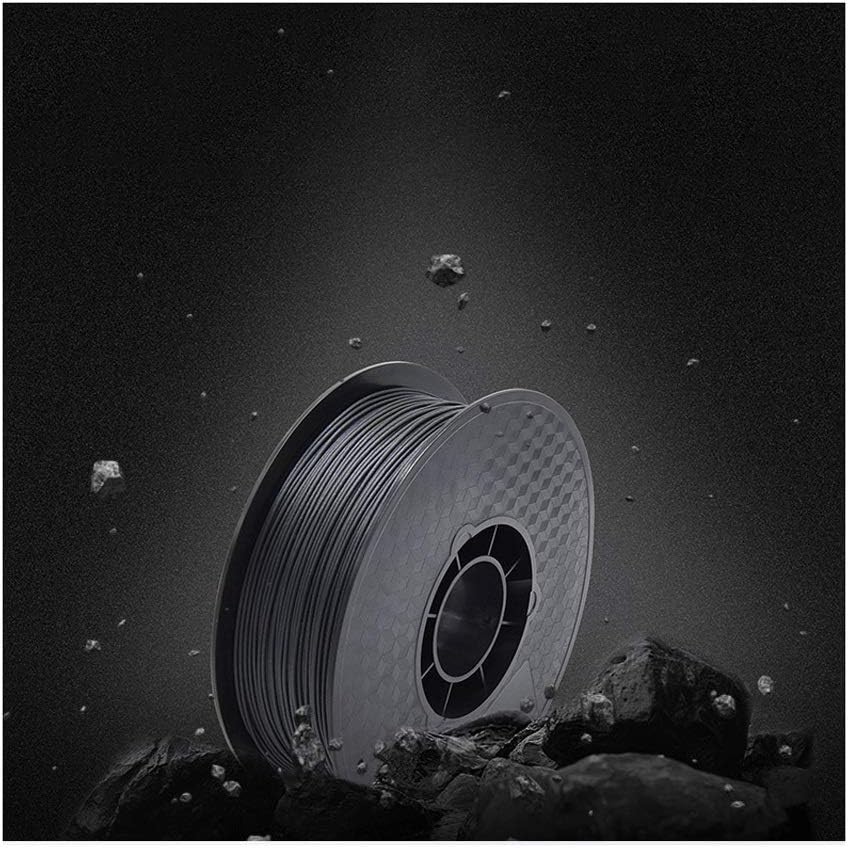Page Contents
Details: 3D Printing Supplies PLA Filament,Carbon Fiber Filament 1.75mm/Precision +/- 0.02mm3D Printing Filament, High Strength and High Toughness Consumption Filament Filament (Color : Pla1.75 Carbon Fiber,
Brand: FARUTA
3D printed PLA consumables 100% green environmentally friendly material, biodegradable, no irritating odor, rest assured 3D printingPerformancePrinting temperature: 230-250 ° CBase plate temperature: No Heat/80°CDensity: 1.23g/cm2Melt index: 20 (250 ° C / 2.16 kg) g/10minTensile strength: 49MpaElongation at break: 228%Bending strength: 68MpaFlexural modulus: 2027MpaLzod notched impact strength: 8Kj/m2Heat distortion temperature: 64 (.C, 0.45Mpa)Line length (1.75): 350-355mThe middle hole of the supply reel can be hung on the printer.The consumables are moderately soft, smooth and delicate, and do not hurt your hands.The consumable line has a good smoothness, the wire diameter is uniform, and the toughness is strong.If you have any questions about the product, please feel free to contact us and we will reply you within 24 hours.good day.
Advantages
- Products can be returned
- High toughness, no tangles, smoother printing. There are no air bubbles in the molded part. The surface of the printed model is smooth and delicate.
- ★. High strength: high axial strength and modulus of carbon fiber consumables, making ,It has higher strength and is durable as a structural part.
- ★. Antistatic: Carbon fiber has the physical effect of conducting static,electricity, which can be timely,The electrical ions on the surface of the print are exported.
- ★. Low shrinkage: carbon fiber consumables have the advantage of low shrinkage and large print,The dimensional model can also perform well.
- ★. Using PLA pure biodegradable materials, precision processing through 210 processes, making printing smoother
Notice
- Is an online purchase
- Delivery may be delayed in some areas.
Buyer Guide 3D Printing Supplies
It’s always a good idea to have a firm understanding of each individual component, and go from there.- Filament, or “muck.” The filament is a plastic used in 3D printing. It’s usually available in different diameters and colors.
- Printer. There are different kinds of 3D printers, including desktop, industrial, and open-source models.
- Software. There are several different types of printing software, including slicers, slicer-creator, and hosts.
- Support Material. Support material is a support material used in 3D printing. There are usually 2 types: soluble support material and solid support material
- PLA (Polylactic acid): PLA filament is biodegradable, renewable, and compostable.
- ABS (Acrylonitrile butadiene styrene): ABS filament is stronger, tougher, and better than PLA.
How to choose 3D Printing Supplies
Choosing 3D printing supplies requires a little bit of experimentation. However, there are a few things to keep in mind when shopping for materials:- The ABS plastic used in 3D-printed objects often has a bit of giving when it’s warm. This makes it ideal for producing small, fragile, or flexible objects.
- PLA (polylactic acid) is a type of biodegradable plastic that’s commonly used by hobbyists and artists. PLA is edible and can be easily recycled after use.
- Supports can be added to 3D printed objects, which help the 3D printed object stay upright during the printing process. Support material can be included in the print file, or removed manually afterward.
How to maintain 3D Printing Supplies
The 3D printer industry is one of the fastest-growing industries on the planet. Though 3D printers are relatively inexpensive, maintaining them can be an expensive task.- Use the right materials. As 3D Printing Supplies noted, different filaments are best suited for different printers, which is why it’s important to be aware of what type your printer needs.
- Use the right temperature. As 3D Printing Supplies noted, 3D printers work best when kept at 110 to 115 degrees Fahrenheit.
- Pay attention to cleaning. As 3D Printing Supplies noted, 3D printers come in a variety of materials, such as ABS, PLA, and PETG. These materials can build upespecially in small areasespecially when the printer is used frequently. Proper cleaning and maintenance can help you get the most out of your 3D printer.




